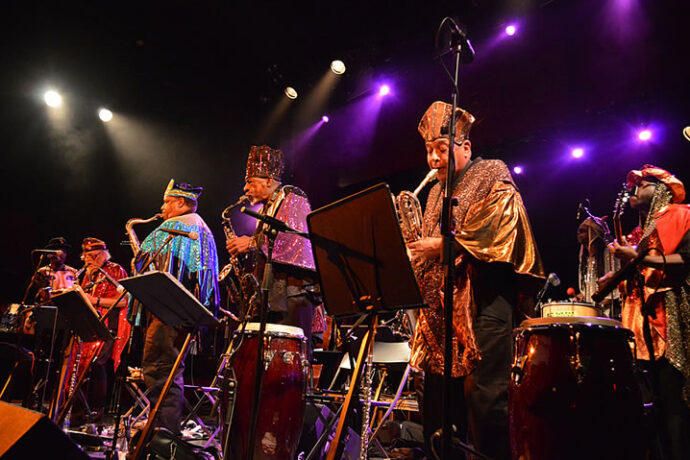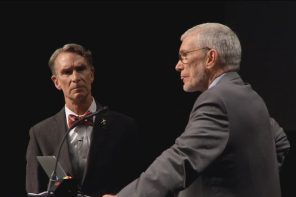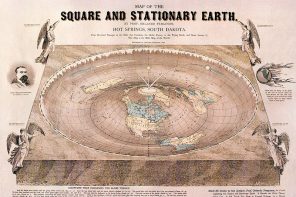Jazz, like religion, eludes strict definitions. It overflows boundaries of genre and form, and, when improvised, is unpredictable and ephemeral. As Jason Bivins documents in his latest book, Spirits Rejoice!: Jazz and American Religion, jazz musicians share with religion scholars certain anti-essentialist leanings.

Spirits Rejoice!: Jazz and American Religion
Jason C. Bivins
Oxford University Press
(May 1, 2015)
The similarities run deeper. Jazz musicians often describe their music as “sacred,” “spiritual,” and conducive of self-realization or social change. The history of jazz in America is one of cultural and sonic recombination, a mingling of traditions and concepts, words and sounds.
Bivins, a professor in the Department of Philosophy and Religious Studies at North Carolina State University, transcribes these riffs with unique expertise. He is himself a jazz musician, and the book accomplishes a unique mashup of words and sound. (It even comes with its own listening guide.)
Last week, The Cubit caught up with Bivins at a Durham coffee shop to discuss jazz, religion, and science, and to ask whether jazz musicians represent the ultimate in “Spiritual But Not Religious” (SBNR).
You write that “religion” and “jazz” are both tricky categories to write about, and that they’re tricky for similar reasons.
The similarity is what ended up surprising me, and it’s not how I started the project. My initial interest was in a certain kind of religious discourse that continually cropped up throughout jazz’s history. But as I began to chase down that question, I had a speedbump that I had to clear and it had a lot to do with terminology.
Because of my own background in jazz reviewing and performance, I knew a lot of folks, I had a lot of contact information, and so when I buckled down with this research in late 2009, early 2010, I composed what I thought was a really good form email and I compiled a list of addresses. The subject line was “Research Project: Jazz and Religion.” And I got very, very few responses. And I was perplexed. I was miffed. I didn’t know how to go forward.
So one night it struck me that maybe the R-word was getting me into trouble, given the contemporary atmosphere with all the conversations about being “Spiritual But Not Religious.” So I thought, let’s do this, let’s go for a Hail Mary pass, and change only the subject line, just that one word—“Research Project: Jazz and Spirituality.” And the responses started pouring in.
So I thought, okay, this is pretty interesting. Is there an actual resistance to the term “religion” or did it simply fail to get on people’s radar because I’d used the word? It turned out it was the latter, because while a lot of folks didn’t know how to define religion, just as we in the academy don’t—and for alarmingly similar reasons, I should add—it turned out they were very interested in kind of dwelling in that inability. And in the inability to finalize terms—which ultimately means the inability to finalize identity: this was something that musicians ended up celebrating.
The very frustrations that bedevil academics are the same things that enable improvisers; our finishing point is their starting point. So that became a kind of interesting hook for me to introduce in the beginning of the book and it shaped a lot of my investigations of the more concrete subcategories.
Did you discover, within jazz, resources for theorizing about religion?
Absolutely. A lot of the methodological conversations that we have in the academy and a lot of the stuff that I’ve written about over the last few years ended up being validated, much to my surprise, by the musicians, by conversations, by performances that I witnessed and so on and so forth. And I thought, all right, this is not just shoptalk, you know?
There are thousands of people living out their lives in ways that seem to reflect theoretical conversations that we have elsewhere; a kind of resistance to attributions, a poetic playfulness, even as these are combined with immensely embodied concrete forms. All of this situated in the complex history of religion and racial representation in the United States. So I was overjoyed to find that there was so much similarity in these practices and the challenge was to transcribe them in what I think are historically, scholarly, but also poetically interesting ways.
So are jazz musicians a great example of “Spiritual But Not Religious”?
I think there are some people who embrace the category, or some of what it implies, but for the most part what I discovered is that there are more jazz musicians participating in actual known religious traditions than I had anticipated. Certainly, universes beyond mere Christianity. And that’s one of the stories I try to tell.
But even when jazz musicians embrace what Ned Rothenberg calls the “smoke,” even when there’s an embrace of the ineffable, there’s always an emphasis on the concrete, on practice, on the momentariness of improvisation, which all require embodiment and focus.
And that’s something that I would not typically associate with a lot of the “Spiritual But Not Religious” crowd who want to resist the associations of the particular, who want to resist belonging to one set of institutions or texts in particular. So what we see in jazz is a combination of the concrete and the abstract in ways that, again, is really reflected in the musical practices themselves. That to me represents something distinct from the SBNR ethos.
So the stereotypical SBNR individual can pick-and-choose, and even combine, but she doesn’t actually have to sit down and practice scales for hours a day. I’d love to hear more about how the bodily practices involved with jazz influence the way musicians talk about spirituality.
I think it influences in almost every way. So on the most general level, when we think about embodiment I think of again another contrast between SBNR and those who seek to “rejoice with spirits.” One of the contrasts is between a socio-economic condition of relative affluence, and, I say with sadness, [one of] increasing socio-economic constraints.
We can’t forget that this is a music of largely African-American origins undertaken by people often at the margins of socio-economic existence and arising during a period of intense discrimination—that shapes both discipline and practice, as well as outcomes.
The world of scales and practicing—hours and hours and hours per day, playing in wedding bands, giving lessons, doing all of these kinds of debasing things in order to make the rent—[produces] preparedness to enter the space and time of invention. And when that happens, whether we’re talking solo performance or performance with other people, it’s at that moment that interactivity is required for the musicians, in order to invoke the spirit.
How was science integrated into jazz? I’m thinking, for example, of musicians like Sun Ra and Milford Graves.
So it’s really interesting. We could actually posit this as an extension of the first question about jazz and religion and simply establish science as another species of self-development, of artistic and intellectual realization and manifestation, for the artists in question. I think that would be accurate as far as their own self-understanding goes, because the very resistance to categorization that initially compelled me and took all these interesting forms would also apply to science.
Jazz and religion and science: we’re accustomed to parceling these things out, associating them with different realms of experience. But according to those who seek to make spirits rejoice, they’re not different realms of human experience, they’re different repertoires. They’re different bodies of expression and depending on the moment, depending on the audience, depending on the aspiration, any one of these repertoires—or several in combination—could be invoked and extended. And we see this really emphatically in the post 60s era with improvisers like the ones you mentioned.
So Milford Graves, for example—a percussionist, inventor, cardiologist, and veterinary scientist—is fundamentally interested in the recalibration of pulse. For Graves, that’s going to require the invocation of several different bodies of knowledge. And he found particularly productive bodies of knowledge that we would label science.
For Graves, if the ultimate goal is to produce some kind of healing, then you have to get in touch with circulatory frequencies and rhythms. You have to be able to quantify and measure them. Once you have the data collated, analyzed, and understood, then you can perform on the basis of that data. And if you’re doing it correctly, not only can you get amazing effects—different pulses, articulating simultaneously in different limbs—you also have the possibility that this creates productive effects among listeners.
So science is necessary not just as a preamble, but as an outcome.
With Sun Ra we have a different understanding of science, one that ultimately influences Anthony Braxton and post-1960s improvisers as well. Here science is much more of an exploration outside of the body. This links to the reality of living in the age of human space exploration, and signals not only the possibility of human travel beyond the body—something that a lot of improvisers are deeply interested in and which some believe is what occurs in moments of improvised peak experiences—but it also establishes a different kind of frontier, an almost fantastical utopian edge.
So science here is moving both deeper within the human and beyond the human altogether.
Let’s talk about improvisation. To paraphrase from your book, jazz improvisation takes place at the ‘edge of a breath,’ poised in that momentary space before the beat of the drum hits the ear. As a jazz musician yourself, did you try to incorporate improv into the writing of this book? And, second, why does improvisation play such a significant role in the spiritual discourses of jazz musicians?
I would even extend that last formulation a bit. Even if the term improvisation is invoked in religious practice, there’s something about what improvisation gets at in terms of the profound finitude of human experience and expression. There’s something about improvisation that’s fundamental to religion.
It’s not just that improvisation is what we do when we’re coloring outside the lines. Improvisation is also a risky step into the unknown. It’s a step that’s undertaken when one knows what one can’t know. So there’s that embrace of finitude and unknowability, and the lack of evidence. That, fundamentally, is what religions are invested in.
Most of the [religions] we’re familiar with of course try to provide something that insiders regard as actual evidence of realities that are out there, if not seen at least felt. But that condition of uncertainty is what I think is common to all modes of improvisation.
I wasn’t able to get to that larger dimension, except for in the conclusion of the book, where I make a claim for experience and for ways that we as authors can write about experience. That’s where a lot of my own sensibilities as a musician came pouring out in the writing process.
I would put this in three stages. First of all, there’s the basic question of, “How do I know this is religious?” Unless we’ve got a title, unless we’ve got an interview, what in the world about a piece of music tells us that it’s religious, whether this is motivational, institutional, or something else? So there’s that dimension of fluidity.
Once we have categories, then there’s the question of transcribing. What do I do with the music in the context of not only writing, but scholarly writing? And the third question, I think, is what are the implications of writing in this way, of thinking in this way, of trying to construct the project in this way? They all hang together.
The first question was relatively easy to answer the more I inundated myself in the vast archive of jazz’s first century. Plus I was pleased to discover that the claims jazz musicians have made, and the practices they have regularly engaged in, are those familiar to us in the study of religion. I was able to say, “Look, here’s this immense repertoire of its own in American religion that we need to think about, and we need to situate religion at the center of any responsible history of jazz.”
As to how I was going to transcribe it, this is where my own experience as a record reviewer came in handy, in the most basic sense of telling the reader what it sounds like. I wanted to be playful in the way I wrote about the music, too, not just try to give an “accurate” sense of the sound, but to play around with category and the genre of writing itself. Because there was no readily available hook for me to find, I became an improviser as well. I had to make stuff up. I had to say, what if we thought about ritual in this way, in the way of jazz? What if we thought about community in the way of jazz?
I also wanted to propose, in writing, the kinds of things the sound proposes in our hearing. And the way I did this was to inundate myself in the music I was writing about at any particular moment. And when I wrote about Cecil Taylor, I listened to Cecil Taylor. When I was thinking about writing about Charles Mingus the next day, I would listen to Charles Mingus at night. If any piece of writing in the book is successful, it was actually responding to the music. And this is something that I’ve learned about in my own improvising as well, something I’ve been doing for over twenty years. I think I have a listener’s sensibility for it and an understanding of what goes on in the moment that’s shaped by my own performance.
I wanted ultimately to play around with authorial guise and genre in ways that I hope have implications beyond simply writing about religion and music and, I hope, give people a sense of possibility in writing about religion in general, and that’s that third level that I mentioned, which I engage overtly in the conclusion.
Just because we’re faced with innumerable limits, not just as authors but as persons, doesn’t mean that we should in any way feel encumbered from, as a good friend of mine, bassist Darren Gray once put it, “diving in and grabbing the monkey.” You gotta just dive in and grab the monkey. Do it. Embrace it. You gotta embrace it.
So you shout on the rooftop, sing the glory of the smoke—instead of pretending that it’s not smoke.





